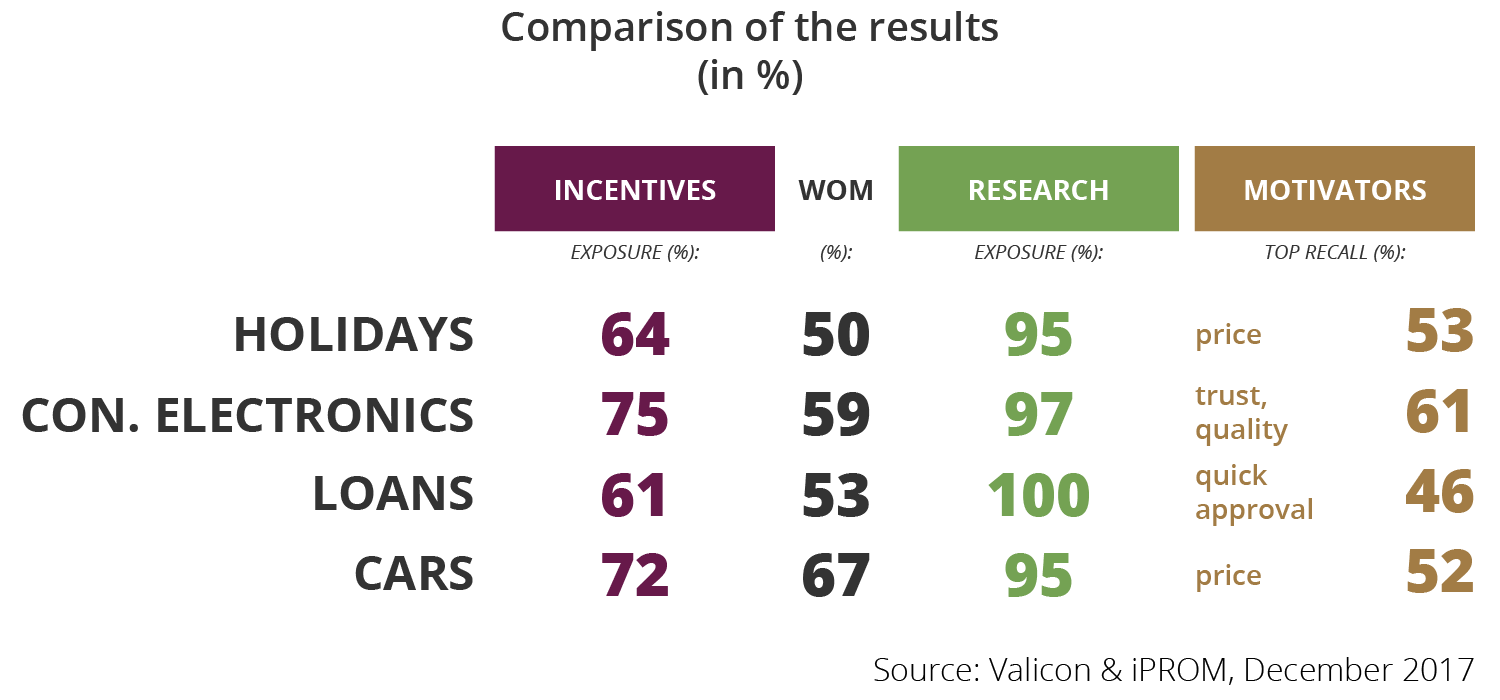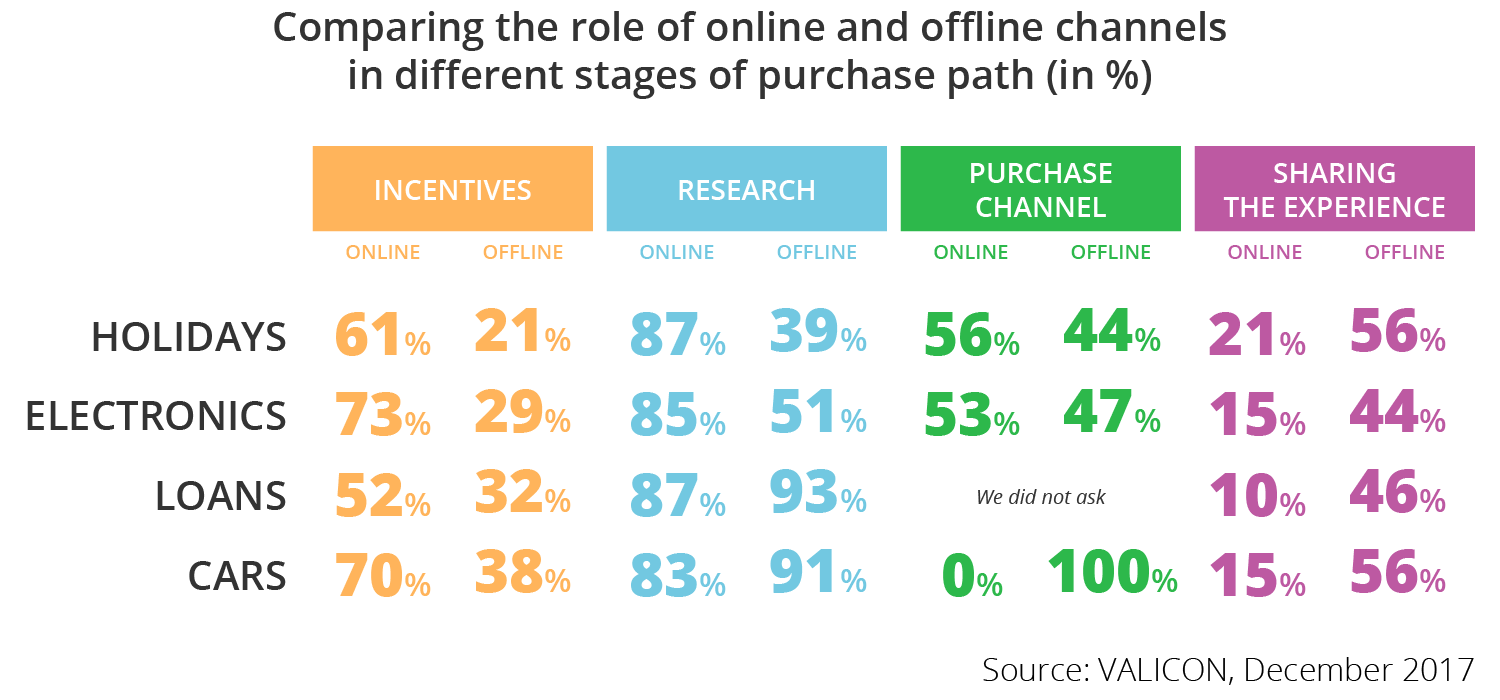Towards the end of 2017, Valicon and iPROM carried out a survey to study the purchase path of Slovenian consumers and determine the role of digital channels in this process. The study has shown which contact points between the buyer and the offer or sellers affect the consumer behaviour across different stages of the purchasing process in four product categories holidays, consumer electronics, loans and cars).
»The main finding is that over the past five years, the purchasing behaviour of consumers hasn’t changed as much as the use of modern technology, which means that consumers need to invest less and less effort in researching a product or service,« said Leon Brenčič, Client Service Director in iPROM.
Despite increased purchasing power, consumers continue to make rational decisions when buying products
Since the recession, we are paying close attention to the purchasing habits and the consumer’s decision-making process. In 2013, digital agency iPROM and research firm Valicon provided insight into the purchasing behaviours of Slovenian consumers across selected product and service categories. At the time, the buyer decision process was influenced by two factors: increased volume of available online information about individual products and services and the recession that forced consumers to rationalize their purchasing behaviour and highlighted the web as a convenient tool in the decisionmaking process.
What changed over the past five years? Even though the recession is over and we are witnessing economic growth and have greater purchasing power, the purchasing decisions remain rational. The purchasing process continues to be ruled by low prices, discounts and recommendations within the social network. On the other hand, there are changes that affect purchasing behaviours, such as the penetration of smart phones which are now owned by twice as many internet users than 5 years ago: 45 percent in 2012 compared to 85 percent in 2017 (Source: Valicon, JazVem online panel).
Studying the purchase path across four categories
To study the buying decision-making process in 2017, Valicon and iPROM used an updated model of measuring the purchase path with a focus on purchase events across four products or service categories: holidays, consumer electronics, loans and cars. The study evaluates the consumer’s path to purchase through seven stages of the purchase process.
The purchase path is a complex and non-linear process during which every consumer collects information, particularly when not making regular daily purchases.
Internet is the main tool in making the decision
The buyer decision processes across all categories share the fact that consumers use the process to gather information by using different sources of information. We rely on the internet (87 percent) over traditional sources (39 percent) when looking up information about holidays. The dominance of the web in the purchasing process in the tourism category is noticeable in general as tourism is an industry where digital media dominates other sources of information. The web is also the leading purchasing channel for tourism products as 56 percent of all purchases are carried out online. The situation is similar in the consumer electronics category, where a little over a half of all purchases are made online. When taking out loans or purchasing a car, the visit to the physical point of sale remains the leading source of information.
Digital advertising significantly impacts the decision once the consumer has entered the purchasing process
Consumer’s attention shifts once they set off on the purchase path. They become more receptive to ads and content related to the category they are researching. When purchasing consumer electronics, 75 percent of the surveyed participants were exposed to advertising messages and content from the relevant area. During the buying decision stage, the web and online advertising gain in importance as related content has a significant impact on the purchasing decision. 73 percent of respondents were exposed to digital advertising in the consumer electronics category and 70 percent in the cars category. In the holiday category, 61 percent of consumers were exposed to online incentives and only 21 percent were exposed to incentives delivered through traditional media and sources.
During the information search stage, a brand’s or seller’s website is a key contact point and more than two thirds of all buyers research it thoroughly. The exception is the process of buying a car, where a good half of the buyers emphasized the importance of the website.
More than a half of all respondents personally mention the purchase
Personal recommendations related to the purchase decision are more common than sharing opinions online (through social networks). More than a half of those who booked their holiday or bought a car shared their experience with their friends, acquaintances or family. Holiday reservations are most commonly shared online. 21 percent of consumers provided a recommendation, most commonly in the form of online comments.
Brands or sellers must constantly optimize the coverage of their contact points on the purchase path
With the mass adoption and increased value, the internet changed consumers and their purchasing habits. The recession just further accelerated the development. Any brand looking to remain relevant on the market must distribute its marketing activities across channels effectively, so it can adapt to market and technology conditions, where online presence is a must.
»Companies or brands that won’t know how to make use of the web have no future. The selection and distribution of advertising channels are an increasingly difficult challenge. That is why knowing and understanding the purchase path is crucial to success,« commented Matjaž Robinšak, Project Director and Partner, Valicon.


Research methodology
The study was carried out between August and November 2017 across four product and service categories. The study surveyed 2,484 of Slovenian users of digital media who actually carried out a purchase within a specific time period (depending on the product or service category). The online survey used the self-administered questionnaire and the measurement method was CAWI. Survey participants were recruited through advertisements on digital and social media and search marketing. iPROM Cloud software reaches 95 percent of Slovenian online users through online and mobile media.
About iPROM
iPROM is a leading regional provider of media and technology solutions for digital advertising on the open web. Our knowledge and experience help our customers streamline the complexities of marketing in the digital environment. By combining advanced technology with the most comprehensive consumer behaviour data on the market, we enable our clients to display the right advertising messages to the right person at the right time on the right device while also helping online publishers grow revenues.
iPROM is a high-tech company that brings together the broadest range of consulting, analytical, media and software solutions needed in digital media advertising. Our continuous investments in technological development help us stay ahead of the competition and keep our clients at the front of the minds of their target audiences.